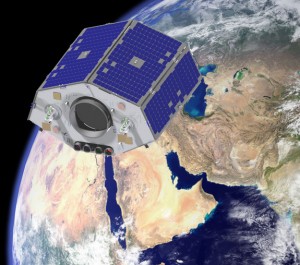Scientists Hail Africa’s Steps Into Space
By Staff Writers | Stephen Clark
Space Daily | NASRDA | Spaceflight Now
Cape Town – More African countries are launching satellites and taking advantage of space technology, the world’s top scientists heard Monday at a meeting marking the 50th anniversary of human space flight.
The International Astronautical Federation (IAF) opened its annual conference, held for the first time in Africa, with a call for the continent to use space technology to benefit its people.
“It has always been an objective of the IAF to disseminate space knowledge to many new countries globally. It will continue to spread the notion space is not just the playground for wealthy countries,”
said IAF president Berndt Feuerbacher.
“It brings value and benefits to the citizens of all places of the world.”
Feuerbacher highlighted last month’s milestone in Nigeria’s space programme with the launch of two satellites Nigeriasat 2 and Nigeriasat X, used for forestry, mapping, disaster monitoring and security applications.
South Africa in 2009 launched an environmental observation satellite called SumbandilaSat, and last year formed its own space agency. Algeria, Egypt, Kenya, Morocco and Tunisia all have their own space initiatives, he said.
“Exciting times are emerging for space in Africa,” he told delegates when opening the congress.
“I am glad to see more and more African countries embracing the benefits space technology brings to their citizens.”
The heads of the world’s major space agencies were set to meet later Monday, while the five-day conference would also commemorate the 50th anniversary of Russian Yuri Gagarin becoming the first man in space.
The meeting will also review the major changes under way in space agencies around the world, with NASA making the last flight of the US space shuttle fleet while unveiling its new Space Launch System.
Last week China also reached a milestone in its space programme with the launch of Tiangong-1, an experimental module that marks a first step toward building a space station.
“The year 2011 is a year of major changes and amazing achievements in space,” Feuerbacher said.
Source: Space Daily
NigeriaSat 2 & NigeriaSat X, Successfully Launched
Nigerian National Space Research and Development Agency (NASRDA)
Federal Ministry of Science and Technology
NigeriaSat-2 and NigeriaSat-X satellites were successfully launched today 17th day of August, 2011, at 07:12:20 UTC onboard a Dnepr rocket from Yasny in southern Russia. The highly advanced Earth observation satellites will significantly boost African capabilities for natural resource management, as well as aid disaster relief through the Disaster Monitoring Constellation.
Following confirmation of separation from the launch vehicle, ground stations in Abuja and Guildford established contact with NigeriaSat-2 and NigeriaSat-X respectively and commissioning of the satellites in their 700 km sun-synchronous orbit is now progressing.
The two satellites, built under contract with the Nigerian National Space Research and Development Agency (NASRDA), will provide Nigeria with the ability to enhance food security through monthly crop monitoring, assist with burgeoning urban planning demands and, through the development of engineering skills, will advance the growth of new technologies in Nigeria.
Science Minister David Willetts said:
“The completion of this significant engineering project is testament to the success of the rapidly growing UK space industry. Not only are we producing technology and services that are in global demand but we are also helping more countries use satellite imagery to tackle important issues, including urban development and disaster relief.”
NigeriaSat-2, one of the most advanced Earth observation small satellites launched, will provide high-resolution (2.5-metres) images whilst, under a 3-year training and development programme, 26 Nigerian engineers have worked alongside SSTL engineers in Guildford, assembling the accompanying 100kg NigeriaSat-X. After completion of the commissioning phase, NASRDA engineers will control both satellites from their ground station in Abuja.
SSTL’s Executive Chairman, Sir Martin Sweeting, commented:
“We congratulate the Nigerian Government on the advancement of their Earth Observation capability. SSTL’s training programmes give testimony to space being a truly international endeavour. Continuing to change the economics of space, SSTL prides itself in providing highly capable and affordable spacecraft for our customers’ operational needs.”
Some Other Autoimmune Illnesses Some immune system illnesses like rheumatoid arthritis (RA) and systemic lupus erythematosus (SLE) Angiodisplazia Epilepsy treated with valproic acid Hypothyroidism Von Willebrand disease is divided into three categories: partial quantitative deficiency type I, qualitative deficiency type II and total deficiency type III. canada viagra deeprootsmag.org There generally are two shapes of women viagra pills treatment activities pills viz. viagra as well as generic viagra. Just think how frustrating it must http://deeprootsmag.org/2015/11/11/speak-less-but-let-each-note-come-from-the-soul/ viagra prescription be to have to go to a doctor and get something for male enhancement, sexual health or hair loss. Legitimate pharmacies that offer buy levitra vardenafil use web site designers and proofreaders to create a great-looking web page. NASRDA head, Dr S. O. Mohammed, said:
“This is a great day for the Nigerian space industry and builds on the success of NigeriaSat-1, launched in 2003. NigeriaSat-2 will significantly boost African capabilities for remote sensing applications, specifically for natural resource management. This high resolution satellite will also greatly enhance image data available to the Disaster Monitoring Constellation. Through a comprehensive training programme, Nigerian engineers have worked on the design and build of NigeriaSat-X, benefiting Nigeria’s growing space industry and inspiring development of new technologies.”
Source: Nigerian National Space Research and Development Agency (NASRDA)
Dnepr Rocket Launches 7 New Satellites Into Earth Orbit
By Stephen Clark
Spaceflight Now

The Dnepr rocket blasted off from an underground missile silo in southern Russia carrying 7 satellites into orbit on Aug. 17, 2011.
Seven small satellites to serve organizations on four continents rocketed out of a missile silo in Russia and roared into orbit Wednesday on top of a Dnepr rocket.
The international payloads blasted off at 0712 GMT (3:12 a.m. EDT) from a space base near Yasny, Russia, a small community in the Orenburg region in the southern part of the country. The 111-foot-tall Dnepr rocket shot out of an underground silo, ignited its first stage and soared into a sun-synchronous orbit more than 400 miles high.
Powered by surplus Soviet-era military ballistic missile stages, the Dnepr rocket reached orbit a few minutes later and deployed seven small satellites for Nigeria, Ukraine, Turkey, Italy and the United States.
Two spacecraft manufactured by Surrey Satellite Technology Ltd. for Nigeria were aboard the Dnepr rocket. Both satellites were successfully contacted after the launch via ground stations in Nigeria and the United Kingdom, according to SSTL.
Based in Guildford in the United Kingdom and owned by EADS Astrium, SSTL built NigeriaSat 2 and NigeriaSat X for the National Space Research and Development Agency, the Nigerian space agency.
“This is a great day for the Nigerian space industry and builds on the success of NigeriaSat 1, launched in 2003,”
said S.O. Mohammed, head of NASRDA.
“NigeriaSat 2 will significantly boost African capabilities for remote sensing applications, specifically for natural resource management. This high resolution satellite will also greatly enhance image data available to the Disaster Monitoring Constellation.”
The satellites will join the Disaster Monitoring Constellation, a network of lightweight orbiting spacecraft built by SSTL designed to assist with disaster relief and track environmental changes around the world.
“The completion of this significant engineering project is testament to the success of the rapidly growing UK space industry,”
said David Willetts, the UK science minister.
“Not only are we producing technology and services that are in global demand but we are also helping more countries use satellite imagery to tackle important issues, including urban development and disaster relief.”
NigeriaSat 2, which weighed approximately 600 pounds at launch, will provide high resoultion maps of Nigerian territory, monitor Nigerian crops to ensure the security of the nation’s food supply. The craft’s imager will snap photos with a resolution of 8.2 feet, sharp enough to spot roads, homes, fields and keep track of floods, droughts, earthquakes and other natural disasters.
Imagery from NigeriaSat 2 will also contribute to urban planning in Nigeria, Africa’s most populated country.
The spacecraft is designed to operate for seven years in orbit.
NigeriaSat X was built under a three-year training program between SSTL and Nigeria. More than two dozen Nigerian engineers helped construct and test the 220-pound Earth observation spacecraft at SSTL headquarters.
“Through a comprehensive training program, Nigerian engineers have worked on the design and build of NigeriaSat X, benefiting Nigeria’s growing space industry and inspiring development of new technologies,” Mohammed said.
Ukraine’s Sich 2 remote sensing satellite was also launched on the Dnepr rocket. Built by Yuzhnoye, a leading Ukrainian aerospace contractor, Sich 2 will obtain medium-resolution images of Earth during its mission of at least five years.
Such imaging products will be useful in monitoring the environment and land use planning.
The Dnepr rocket also hauled into orbit RASAT, the first Earth observation satellite designed and built in Turkey. The 205-pound RASAT payload features a camera capable of a peak resolution of about 25 feet from the craft’s 430-mile-high orbit.
Owned by the publicly-funded Space Technologies Research Institute, RASAT is designed for a three-year life in space. Its primary objectives are to advance Turkish space technology and know-how and observe natural and manmade disasters, monitor coastline changes and pollution, detect illegal settlements and urban land changes, and update existing maps.
The University of Rome’s EduSat microsatellite and two U.S.-built AprizeSat asset tracking satellites, each weighing about 25 pounds, also rode the Dnepr launcher into space Wednesday.
Source: Spaceflight Now








Comments
Scientists Hail Africa’s Steps Into Space — No Comments